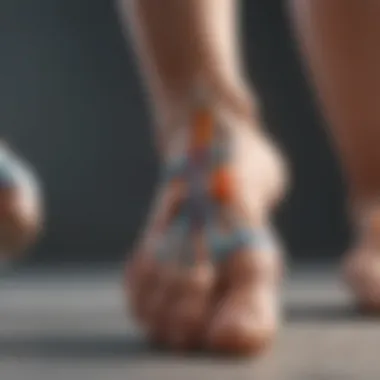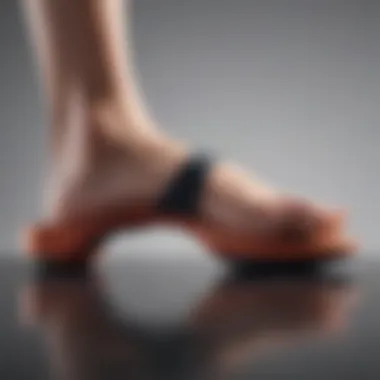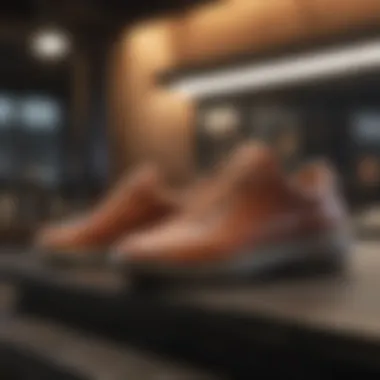The Importance of Arch Footwear in Modern Design


Overview of Research Topic
Brief Background and Context
Arch footwear refers to shoes designed with specific structures to support the arch of the foot. This design has gained prominence in recent years as more individuals become aware of the importance of foot health. The foot's anatomy is complex, consisting of bones, muscles, and ligaments that work together to provide balance and mobility. Insufficient support can lead to various ailments like plantar fasciitis, flat feet, and other musculoskeletal issues.
With a growing focus on wellness and preventive health, arch footwear has emerged as a significant component in modern footwear design. As consumers increasingly prioritize comfort and support over aesthetics, footwear manufacturers are adapting their technologies and designs to meet these needs.
Importance in Current Scientific Landscape
The study of arch footwear intersects with multiple disciplines, including biomechanics, ergonomics, and material science. Recent advancements in these fields provide deeper insights into how understanding foot dynamics can improve footwear design. This knowledge base not only informs manufacturers but also aids consumers in making more informed decisions regarding their footwear choices. By emphasizing arch support, manufacturers play a vital role in enhancing overall body alignment and reducing the risk of injury.
Through the lens of public health, comfortable and supportive shoes are essential to promoting physical activity, reducing healthcare costs, and improving quality of life. Thus, recognizing the significance of arch footwear is crucial for both consumers and professionals in the field.
Methodology
Research Design and Approach
The research on arch footwear employs a mix of qualitative and quantitative methods. Surveys and focus groups are conducted to understand consumer preferences regarding arch support and comfort. Additionally, biomechanical studies analyze how different arch designs affect user experience under various conditions.
Data Collection Techniques
Data is gathered through a variety of techniques:
- Surveys: Targeted at regular shoe buyers to assess their preferences and experiences with arch footwear.
- Biomechanical Testing: Measurements taken during activities to evaluate the performance of different footwear designs under stress.
- Market Analysis: Evaluating sales data and trends to understand the impact of arch footwear on the broader industry.
Prolusion to Arch Footwear
In the realm of modern footwear design, arch support plays a central role. Arch footwear addresses an essential aspect of how our feet function. The significance of arch footwear does not merely rest on comfort. Rather, it encompasses the intricate relationship between our foot health and overall well-being. Designing shoes with suitable arch support helps to alleviate common foot problems and enhance performance in various activities.
Definition and Importance of Arch Footwear
Arch footwear refers to shoes specifically designed to support the natural arch of the foot. The arch provides stability and distributes weight evenly across the feet. When the arch is appropriately supported, it contributes positively to biomechanics of walking and running. The right arch footwear can mitigate discomfort and prevent issues such as plantar fasciitis, shin splints, and other musculoskeletal disorders.
The importance of arch footwear extends beyond mere pain prevention. It can enhance athletic performance, improve posture, and reduce fatigue. People often underestimate how footwear can impact daily activities, from a leisurely walk to intense sports. Thus, understanding what makes arch footwear significant is crucial for anyone serious about maintaining foot health and general well-being.
Historical Context of Footwear Development
To appreciate the significance of arch footwear, we must look back at the evolution of footwear design. Historically, shoes were primarily functional. Ancient cultures utilized materials that offered basic protection to the feet. Over time, as societies advanced, the understanding of foot mechanics improved too.
In the 20th century, the rise of orthopedic shoes marked a major milestone. These shoes focused on medical and rehabilitative needs, emphasizing arch support as a key element. Designers began exploring materials and technologies to enhance comfort and performance. The introduction of cushioning materials revolutionized footwear, making it more accessible for the general public.
Today, the contemporary focus combines aesthetics and function. Consumers are more aware of the significance of arch support, leading brands to innovate and enhance their product offerings. As we delve deeper into this article, we will uncover how these developments continue to shape modern footwear design.
Anatomy of the Foot
Understanding the anatomy of the foot is critical in the context of arch footwear and its design. Each part of the foot plays its own role, and together, they contribute to overall body mechanics. A comprehensive understanding helps in designing footwear that supports natural movement and posture, reducing the risk of injury and discomfort.


Foot Structure and Function
The foot consists of 26 bones, more than 100 muscles, tendons, and ligaments. It is divided into three main sections: the forefoot, midfoot, and hindfoot. Each section serves distinct functions. The forefoot includes the toes and the ball of the foot, providing balance during walking and running. The midfoot acts as an arch, absorbing shocks, while the hindfoot comprises the heel and ankle bones, providing stability and support.
The structural integrity is essential for maintaining proper function. The arch plays a significant factor here. It helps with weight distribution and provides an elastic mechanism that enhances movement efficiency. The foot's muscles and tendons work together to enable proper articulation, making it a complex system designed for flexibility and support.
The Biomechanics of the Foot
Biomechanics refers to the study of the mechanical principles of living organisms. In the foot, understanding biomechanics is crucial for determining how it moves and interacts with the ground. Each foot strike during walking or running involves a series of motions: heel strike, midstance, and toe-off.
Proper footwear, particularly arch support, influences these movements significantly. It affects how pressure is distributed across the foot, impacting gait and posture. For instance, inadequate arch support can lead to excessive pronation or supination, potentially leading to foot pain or various musculoskeletal problems.
"Inadequate arch support can lead to excessive pronation or supination, impacting overall health."
Understanding the foot's biomechanics is vital. This knowledge helps create footwear that not only fits well but also supports healthy movement patterns. It enhances comfort and can prevent long-term issues related to improper foot alignment.
In summary, a thorough comprehension of both the structure and biomechanics of the foot is essential for effective arch footwear design. Such understanding informs not only the aesthetic aspects of footwear but also its functional capacity, directly influencing the user's overall health and wellness.
Understanding Arch Types
In the realm of footwear design, understanding arch types is essential for creating shoes that align with human anatomy and promote healthy foot mechanics. The arch of the foot plays a significant role in weight distribution, shock absorption, and overall comfort. A comprehensive grasp of arch types allows designers to tailor footwear that meets the specific needs of diverse individuals. Therefore, recognizing the different arch formations enables both innovative design solutions and informed consumer choices.
Normal Arch
A normal arch, often considered the ideal arch type, possesses a moderate curve that adequately supports the foot's natural mechanics. It provides an effective balance between flexibility and stability, making it suitable for a wide range of activities. Footwear designed for individuals with a normal arch is generally made with standard cushioning and support. Adequate arch support facilitates efficient energy transfer, reducing fatigue. This can be particularly beneficial for athletes and individuals who maintain an active lifestyle.
Flat Arch
A flat arch, or pes planus, occurs when there is little to no curvature in the arch. This condition can lead to overpronation, where the foot rolls inward excessively during walking or running. Therefore, footwear designed for flat arches must prioritize stability and control. Utilizing features such as firmer materials and enhanced cushioning helps manage the foot's motion more effectively, reducing the risk of injury. Moreover, individuals with flat arches may experience discomfort and overuse injuries, making it crucial to select shoes tailored to their unique foot structure.
High Arch
High arches, or pes cavus, present a drastically elevated arch that can result in underpronation. Individuals with a high arch often experience increased pressure on the heel and the balls of the foot, leading to potential discomfort. Footwear for high arches typically incorporates ample cushioning to absorb impact and redistribute weight. These specialized designs also help to improve overall shock absorption, which is vital for reducing strain on both the feet and the body. Moreover, selecting appropriate footwear can mitigate the risk of common issues such as plantar fasciitis and metatarsalgia.
Understanding arch types not only enhances comfort but also promotes overall foot health, making it a cornerstone of effective footwear design.
Principles of Arch Support
Arch support plays a crucial role in the overall effectiveness and comfort of footwear. Proper arch support is not just a feature but a necessity for many individuals. It ensures that the foot is properly aligned, which can prevent numerous issues associated with poor foot health. The main focus in this section is to understand how various factors contribute to the principles of arch support and its significance in footwear design.
The Role of Padding and Cushioning
Padding and cushioning are essential components of arch footwear. They work together to absorb impact and pressure while providing comfort. Different materials, such as Ethylene Vinyl Acetate (EVA) and memory foam, have unique properties that enhance this.
- Impact Absorption: High-quality padding helps in dispersing the force of each step, which can reduce fatigue.
- Comfort: A cushioned footbed makes footwear more enjoyable to wear for extended periods.
- Temperature Regulation: Several materials also help to wick away moisture and keep the feet cool.
When selecting arch footwear, considering the type and thickness of padding is important. Thicker cushioning may feel more luxurious, but it could also compromise stability. Customers should assess their lifestyle needs, whether they require additional comfort for casual wear or enhanced support for professional use.
Effects of Arch Support on Gait


The influence of arch support on an individual's gait is profound. When the arch of the foot is properly supported, the alignment of the entire body can improve. This alignment can lead to several benefits:
- Improved Stability: When arch support is provided, stability in walking and running is enhanced. It reduces the likelihood of injuries from falls or missteps.
- Efficient Energy Transfer: Feet with proper arch support can transfer energy more efficiently from the ground into the body. This leads to less fatigue during physical activities.
- Pain Reduction: Effective arch support can alleviate pain in the feet, knees, and even hips. This is especially true for individuals with conditions like plantar fasciitis or flat feet.
Materials Used in Arch Footwear
The materials utilized in arch footwear play a vital role in shaping its comfort, durability, and overall effectiveness in providing arch support. With the growing awareness of foot health, the selection of materials has evolved to meet not just functional demands, but also consumer aesthetics. High-quality materials not only enhance the wearability of the footwear but also contribute to the long-term health of the feet, making this topic essential in modern footwear design.
Common Materials and Their Properties
Various materials characterize arch footwear, each with specific attributes that contribute to the overall performance. Some of the most common materials include:
- EVA (Ethylene Vinyl Acetate): Widely used due to its cushioning properties. EVA is lightweight, flexible, and durable, providing responsive cushioning that conforms to the foot's shape.
- PU (Polyurethane): Known for its robustness and resistance to wear. PU is favored for its stability. It helps retain the footwear's shape over time and offers increased arch support through structured footbeds.
- Ortholite Foam: This material is known for its excellent moisture-wicking properties and breathability, essential for maintaining comfort during extended wear. Ortholite foam provides cushioning without sacrificing support, allowing for both comfort and longevity.
- Leather: Often used for the upper part of footwear, leather offers durability and breathability. With proper care, leather can mold to the foot over time, enhancing fit and comfort.
Each material brings unique benefits and challenges. The consideration of foot health, specifically regarding arch support, emphasizes the need for proper selection. Quality materials can prevent common foot ailments, such as plantar fasciitis and overpronation, by adequately supporting the arch and aligning the foot during movement.
Innovations in Footwear Materials
Innovation in materials drives advancements in arch footwear design. 3D printing technology is one noteworthy development. This method allows for creating customized insoles and footbeds tailored to an individual’s foot shape. As a result, manufacturers can produce specialized support that meets the unique needs of each user.
Another significant trend is the use of recycled materials in the production of footwear. Brands are increasingly adopting sustainable practices, which not only appeals to environmentally conscious consumers but also promotes longevity in products. Materials such as recycled polyester and upcycled rubber show promise in maintaining performance while being eco-friendly.
Furthermore, advancements in smart materials have emerged. These materials can adapt their properties based on environmental conditions. For example, some can change firmness based on temperature or pressure, offering better support during various activities.
The shift towards innovative materials reflects an understanding of user demands and a commitment to improving the functionality of arch footwear.
"The right combination of materials can significantly enhance the efficacy of arch footwear, extending its benefits beyond mere comfort."
Health Implications of Footwear Choices
The selection of appropriate footwear carries substantial health implications. Inadequate shoes can lead to various foot problems and adversely affect overall musculoskeletal health. Understanding how footwear influences our bodies empowers consumers to make informed choices.
Common Foot Problems Associated with Poor Footwear
Wearing poor footwear can result in numerous foot issues. Some of these problems include:
- Plantar Fasciitis: This is a common condition where the connective tissue on the bottom of the foot becomes inflamed. High-heeled or poorly cushioned shoes often contribute to this problem.
- Bunions: These bony bumps form at the base of the big toe due to misalignment. Tight or narrow shoes tend to exacerbate this condition.
- Blisters and Calluses: Ill-fitting shoes create friction, leading to blisters and thickened skin areas known as calluses.
- Flat Feet and Overpronation: Lack of arch support can lead to flat feet. This can result in overpronation, where the foot rolls inward excessively during walking or running.
Each of these issues can cause discomfort and long-term damage if left unaddressed.
Impact on Overall Musculoskeletal Health
The effects of footwear extend beyond the feet. Poor shoe choices can negatively impact the entire musculoskeletal system, leading to various complications:
- Knee Pain: Misalignment from inappropriate footwear can lead to increased stress on the knees, often resulting in pain and injury.
- Hip and Lower Back Issues: Footwear that fails to provide adequate support can alter body posture, leading to discomfort in the hips and lower back. This may produce chronic pain and reduced mobility over time.
- Balance and Stability: Shoes lacking proper support can affect balance. Individuals may experience a higher risk of falls, particularly in older adults or those with preexisting conditions.
"Quality footwear is not only about comfort but also a matter of long-term health. This is especially critical for individuals who are on their feet for extended periods."
Current Market Trends in Arch Footwear


The focus on arch footwear has intensified in recent years. Increasing awareness about foot health and comfort plays a significant role in this trend. Consumers are now seeking footwear that not only fits well but also provides adequate support. The demand for arch footwear reflects a shift towards prioritizing health alongside style. The balance between aesthetics and functionality is what modern consumers desire most.
Consumer Preferences and Choices
Consumer behaviors are changing swiftly. Many individuals now prioritize comfort over fashion, especially when it comes to everyday footwear. People are more educated about the benefits of arch support, which influences their purchasing decisions. The following factors are crucial in shaping consumer preferences:
- Health Awareness: Shoppers are increasingly conscious of the long-term effects of poor footwear. This has propelled interest in shoes that offer better arch support.
- Lifestyle Considerations: With more people leading active lives, there is a growing need for footwear that can withstand various activities.
- Aesthetics: While function is vital, appearance still ranks high. Consumers want shoes that don’t compromise their style.
- Sustainability: Eco-friendly materials and ethical production processes are becoming deciding factors. Shoppers prefer brands that prioritize sustainability.
By acknowledging these preferences, brands can tailor their products to meet the needs and expectations of modern consumers. Brands targeting arch support must understand these shifting requirements to stay relevant in the competitive market.
Leading Brands in the Arch Footwear Segment
Many companies have carved out niches in the arch footwear market. Some leading brands are known for their commitment to quality, comfort, and innovation. Here are a few noteworthy names:
- Asics: Recognized for their comprehensive range of arch-support shoes. They invest in research to understand foot health better.
- New Balance: Offers customized footwear solutions, catering to various arch types and sizes. Their emphasis on fit has garnered a loyal customer base.
- Saucony: Focuses on running shoes but has expanded to include options that support the arch effectively.
- Hoka One One: Known for their maximalist shoes, which provide substantial cushioning and arch support.
The choices consumers make today can shape the future of footwear design, urging brands to innovate continuously and prioritize health alongside style.
In summary, understanding current market trends is vital for anyone involved in footwear design, retail, or education. It enhances knowledge regarding consumer behavior, allowing for better product development and positioning in the market.
The Role of Technology in Arch Footwear Design
The integration of technology in arch footwear design marks a significant shift in how footwear is crafted. Modern techniques enable designers and manufacturers to create shoes that not only provide support but also enhance comfort and performance. The importance of technology cannot be overstated, as it addresses the fundamental aspects of fit, durability, and usability.
Advancements in Footwear Technology
Innovations in materials and design techniques have transformed arch footwear in recent years. For instance, the development of moisture-wicking fabrics has improved breathability and comfort. Similarly, advanced cushioning systems are now engineered to absorb shock, catering to different arch types. Additionally, improvements in the manufacturing process, such as the use of computer-aided design (CAD), allow for more precise measurements and customizations. These advancements lead to shoes that adapt better to the individual needs of wearers.
Another notable advancement is the implementation of smart technology in footwear. Some brands are now incorporating sensors that track movement and provide feedback on gait and posture. This information is invaluable for both casual users and athletes, helping to prevent injury and improve overall foot health.
Customization and 3D Printing in Footwear
Customization has gained traction in footwear design, thanks largely to technological advancements. With the emergence of 3D printing, it is now possible to create custom shoe insoles that provide tailored arch support. This is especially beneficial for individuals with specific foot conditions, as traditional sizing often fails to encompass varied foot shapes and arches.
3D printing also allows for rapid prototyping. Designers can test and refine their creations faster, leading to quicker product releases in the market. This flexibility ensures that consumers can access the latest innovations in footwear design sooner. Furthermore, it reduces waste and environmental impact, aligning with the growing consumer demand for sustainable practices in manufacturing.
The End
The importance of understanding the significance of arch footwear within modern footwear design cannot be understated. This article has explored various aspects of arch footwear, illustrating its crucial role in enhancing comfort, support, and overall health. A well-designed footwear system focuses on arch support, which directly contributes to improved well-being and mobility.
Summary of Key Insights
Several key insights emerge from the exploration of arch footwear. First, it is clear that the anatomy of the foot plays a pivotal role in determining the necessary support each individual requires. The classification of arch types—normal, flat, and high—highlights the diversity of needs among users. Each type has unique implications for shoe design, influencing how the shoe should be constructed.
Moreover, the principles of arch support underscore how effective customization can mitigate common foot-related ailments. The incorporation of quality materials enhances not only durability but also the comfort necessary for everyday wear. Additionally, consumer preferences reflect a growing awareness of the importance of arch support, with many brands adapting their product lines to address these demands.
Future Directions in Arch Footwear Research
Looking forward, future research in arch footwear is likely to focus on several critical areas. Advances in technology, particularly in 3D printing, promise to enhance personalization in footwear design. This approach could lead to tailored solutions that mitigate specific foot problems more effectively.
- Furthermore, ongoing studies into the long-term health impacts of footwear choices will be vital. Research may also explore how different materials can be optimized to create sustainable yet supportive footwear. The synergy between consumer trends and technological advancements indicates a promising future for arch footwear design, potentially leading to broader applications in therapeutic contexts and beyond.*
"Investing in arch footwear is not just about comfort, it is about investing in one’s long-term health."
In summary, the insights gleaned from this article present a roadmap for those interested in footwear design and its implications for health. Further exploration in this field holds the promise of developing innovative solutions for the diverse needs of the population.



